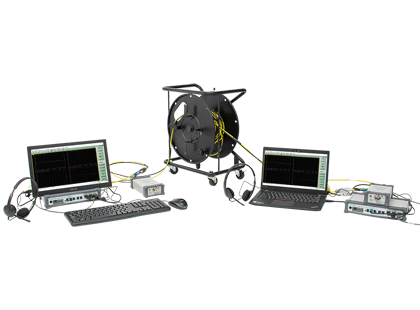
Modular 2-port VNA Family at Frequencies Up to 43.5 GHz
Anritsu Company introduces the ShockLine��ME7868A�family of modular 2-port vector network analyzers (VNAs) that can conduct full vector S-parameter measurements over wide distances of up to 100 meters. Consisting of two MS46131A 1-port VNAs with the PhaseLyncTM synchronization option hardware and accessories, the�ME7868A�VNA uses the MS46131As as portable VNA ports to directly connect to the device under test (DUT) to deliver vector transmission measurements over longer lengths and at a lower cost. The VNAs offer multiple advantages compared to traditional solutions that use 2-port VNAs with very high dynamic range and require long and expensive phase stable microwave cables to reach the DUT.
Available in 8 GHz, 20 GHz, and 43.5 GHz frequency models, the�ME7868A�series supports multiple existing and emerging commercial and military applications, including high frequency 5G. As the first modular-port-based VNA, the�ME7868A�eliminates the need for long port cables to measure transmission over distance for applications such as outdoor antenna range testing, over-the-air (OTA) chamber installations, large vehicle (aircraft, ship) electromagnetic characterization (shielding, RF propagation), and long-distance cable insertion loss measurements.
The new PhaseLync technology enables two MS46131A 1-port VNAs to phase synchronize with each other over a distance of up to 100 meters for the first time. PhaseLync improves dynamic range and measurement stability of s-parameter measurements by eliminating the need for long cables with conventional benchtop VNAs. The result is greater cost and operational efficiencies when measuring transmission over distance.
Very lightweight and extremely compact, the two MS46131A 1-port VNAs that comprise the�ME7868A�are USB controlled via an external PC running ShockLine software. Engineers can easily configure and control MS46131A VNAs from a single PC to conveniently match port count to test setup requirements. Data is more secure, as all measurement results are stored on the PC, rather than the VNA, making the solution well suited for confidential testing environments. Analysis and documentation are also simplified, as there is no need to transfer data off the onboard instrument memory.
 Phase Control with Galvanic Isolation
Phase Control with Galvanic Isolation  Tektronix unveils SignalVu Spectrum Analyzer Software Version 5.4 for analysis of up to eight simultaneous signals
Tektronix unveils SignalVu Spectrum Analyzer Software Version 5.4 for analysis of up to eight simultaneous signals  W�rth Elektronik expands its range of power inductors
W�rth Elektronik expands its range of power inductors  Discover the future of 24/7 EMF monitoring with Narda SMARTS AMC!
Discover the future of 24/7 EMF monitoring with Narda SMARTS AMC!  What is gPTP?
What is gPTP?